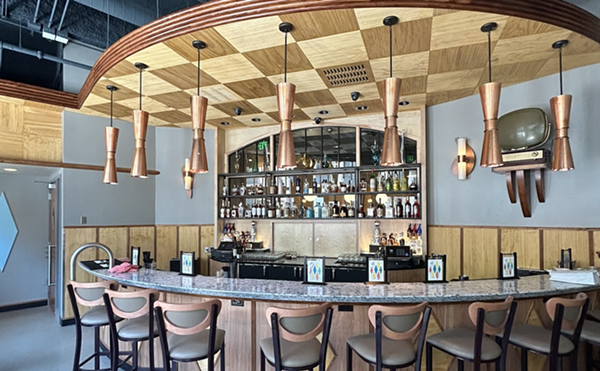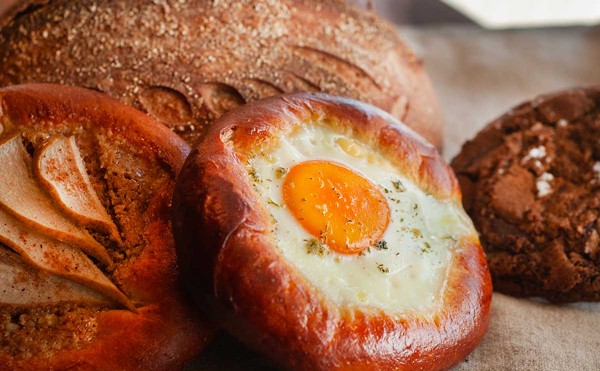For me, the culinary associations of summer include fresh sweet corn, ripe, juicy tomatoes and barbecued ribs. For the record, ribs which are baked in the oven and then slathered with barbecue sauce are just roast pork, not barbecue. Real barbecue is cooked low and slow — that is, at low temperature, very slowly.
Pork ribs, in their natural state, are rather nasty — fatty, high bone-to-meat content, inedible cartilage running across the tips. Like other “soul food” cuts of meat, they are said to have evolved as poor folks who couldn’t afford to eat “high off the hog” devised ways to make the lesser cuts more edible. This resulted in slow cooking, which breaks down tough muscles, and in the use of more seasonings to enhance the flavor.
We now consider good ribs to be a delicacy.
I’ve been cooking bones for 25 years, constantly trying to hone my skills and improve the end result. Five or six years ago, at the jazz festival in Hart Plaza, I saw a cloud of smoke rising from one of the stairways to the lower level. I walked down to find Tony McGee manning a couple of large pits, managing the progress of 40 or 50 slabs. We instantly became friends. He even let me cook with him at subsequent festivals in Detroit and at the Pontiac Rib Fest. And he confirmed that I had been doing it right.
If you’ve ever thought about entering a barbecue competition, consider standing outdoors in the sweltering heat of summer for several hours, reaching over a hot grill, flipping dozens of 3- to 4-pound slabs of spare ribs with tongs digging into your hand while throngs of hungry people are — hopefully — clamoring for a taste. I told McGee that he did not ever have to worry about imparting any of his secrets, as I would never be competing.
When I let friends choose a menu, they frequently opt for ribs. I even have two vegetarian friends who request a bone or two, “just to see what the fuss is all about.” When anyone asks if I’ll share my recipe, I explain that it isn’t a recipe, but a process: selection of the meat, trimming and seasoning, cooking and saucing. The following is my best attempt to give you some tools for success. I should warn you — there is no substitute for experience. Don’t be intimidated. Give it a try. When you put down a slab of mahogany-colored, crisp, moist, delectable ribs, your friends’ praise will likely give you the incentive to do it again next week. You will know you’re hooked when you cook in the rain.
Start by buying some good, meaty ribs. I use full slabs with the brisket and tips still attached, not baby back ribs, which are an entirely different cut. I favor slabs that are close to 3 pounds, with lots of meat visible between the bones. I try to get an expert in the meat department to pick them for me. Flattery will get you everywhere. Get at least two racks. If you don’t finish them, freeze what’s left. They reheat easily on the grill.
Trim them as much as you can. The most important part to remove is the membrane on the underside. Loosen a corner with a knife and grip the end with a paper towel and slowly remove the rest. If you are careful, it will come off in one piece. I always rinse the meat under cold water to remove any bone chips that might result from the saw-cutting.
Put the ribs on a baking sheet or a bus tub — available at Gordon Foods for $5. Sprinkle them with some cider vinegar and Worcestershire sauce to moisten them; that way the rub (see recipe below) will adhere better. Coat the meat all over with a few tablespoons of rub, and put them in a plastic bag or cover them in the pan. An alternative to a rub is to use lots of salt and pepper and chopped lemons and onions and forget about using the sauce. I like to let the meat steep in the fridge overnight to absorb the flavors. Boiling the meat will remove some of the fat, but it will take out some of the flavor too. Don’t do it.
Now you are ready to cook. Fill a spray bottle with water in case you need to extinguish any flare-ups. I always use a charcoal fire. I usually use a Weber kettle grill. It will require much less charcoal than most people use. You want a low fire, not a raging inferno. Start a fire with 40 or 50 briquettes and let them burn until a gray ash coats them. Put the ribs on the grill, turning them frequently to brown them. Add a handful of water-soaked hardwood such as hickory or mesquite to the coals, then cover the grill and let the meat smoke. Adjust the vents to keep the fire temperature low, but be careful not to let it go out. Removing the lid will allow the fire to get hotter.
I like to spray the ribs with a mixture of water and vinegar to help keep them moist. They should cook for about three hours, depending on the size of the ribs and the heat of the grill. Slow cooking will sometimes create a pink smoke ring on the meat.
You will learn to tell the difference between this and undercooked pork. To test for doneness, pull apart two bones. If they come separate easily, they are done. You can add sauce now to let it glaze the meat or serve it hot on the side. Ribs which have been well seasoned and slow cooked don’t need sauce, but it never hurts to use some.
Give ribs a try. They sound complicated, but they become an excuse to be outdoors and to drink a beer or two before enjoying a good meal. Throw together some potato salad or coleslaw and get some fresh corn. You’ll increase your circle of friends.
Barbecue rub
1 tablespoon each: salt, brown sugar, paprika, onion powder, garlic powder, cayenne pepper, chili powder, black pepper, celery seed.
Mix and store in an airtight container.
Barbecue sauce
1 or 2 cups of catsup
1/4 - 1/2 cup of cider vinegar or lemon juice
1/4 - 1/2 cup of brown sugar
1/4 - 1/2 cup Worcestershire sauce
1 tablespoon each: Tabasco sauce, mustard, and barbecue rub.
Combine and heat before serving.
I like to sauté a small finely chopped onion and a clove or two of minced garlic in a few tablespoons of butter before adding the other ingredients. It makes a more complex sauce. A tablespoon of cayenne will really heat it up! As with all recipes, make it the way you like to eat it.
Jeff Broder is a chowhound for Metro Times. Send comments to [email protected]




